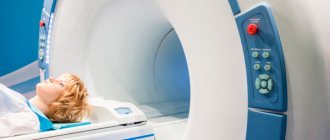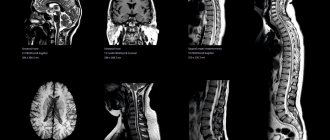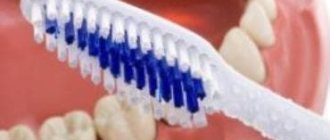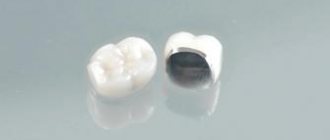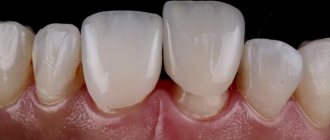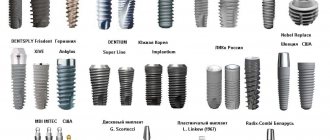Why are things made of metals removed before an MRI?
Features of titanium implants Crowns and pins Conclusions If you have ever had a magnetic resonance imaging scan, you know that before the examinations you are asked to remove all metal objects. With rings and earrings everything is simple. Is it possible to do an MRI with dental implants? After all, they cannot be removed during the procedure.
Why are things made of metals removed before an MRI?
The principle of operation of a magnetic resonance imaging scanner is to create its own magnetic field in which the patient is located. Hydrogen atoms in the patient's body resonate with a magnetic field and the result is recorded as a series of images. These are virtual sections of organs and tissues that help make an accurate diagnosis.
Doctors ask that metal objects be left outside the room with the tomograph so that any metal or alloy that can be magnetized does not accidentally enter the magnetic field. All substances are divided into:
- Diamagnets
. Their magnetic susceptibility is negative. Silicon, gold, silver are diamagnetic. - Paramagnets
. They are capable of magnetization, but their magnetic susceptibility is very weak and difficult to detect, so only scientists understand the difference between dia- and paramagnets. Platinum and aluminum are paramagnetic. - Ferromagnets
. The magnetic susceptibility of such metals is high; they are capable of magnetization and change location under the influence of a magnetic field. Iron, cobalt, nickel are ferromagnetic.
Based on these properties, doctors ask to remove metal objects during magnetic tomography. Ferromagnets not only distort images and heat up in a magnetic field, but can also shift under its influence.
With which prostheses is it unacceptable to perform magnetic resonance diagnostics?
Although it is permissible to do an MRI with dental implants. During this examination, “internal” images of the body are obtained. A magnetic field is created in the tomograph, and the patient is placed in it.
The patient does not feel pain, and MRI does not damage tissues. The magnetic field created by the tomograph is 10 thousand times stronger than the Earth's magnetic field. It has the ability to attract objects that contain metal. If there are elements made of ferromagnetic materials in the magnetic resonance examination field, a potential threat arises. For this reason, people who have metal clamps on the aneurysm are not allowed to be diagnosed. The magnet can move the clamp - this will damage the vessel.
MRI diagnostics cannot be performed in the presence of the following types of implants:
- Cardio;
- Neuro;
- Ear;
- Containers that provide dosed dispensing of medications.
All electronic elements in the body, whose functioning can be disrupted under the influence of a magnetic field, the movement of which can create a health hazard - a limitation for MRI. But there are always exceptions, these include implants whose passport indicates their compatibility with the procedure.
Is it possible to do MRI with titanium implants?
Titanium is paramagnetic
.
Theoretically, it is magnetized. In practice, its magnetic susceptibility is 10 -5
. Such values are so small that in everyday life we say that titanium is not magnetized. It interacts with the magnetic field within limits that do not in any way affect the examination results. It is possible to do MRI with dental implants of all organs, including MRI of the brain. Fears that implants will move are unfounded, for the simple reason that titanium is not ferromagnetic. It does not heat up or change location under the influence of a magnet. Implantation is not a contraindication for tomography.
What about crowns and pins?
The question arises: what about the crowns that are placed on the implant? Some of them contain metals.
Modern metal dental crowns are created from alloys with weak or negative magnetic susceptibility. However, crowns that are many years old can distort the image and negate the diagnosis. Moreover, the more crowns, the stronger the distortion.
In principle, it is possible to do an MRI with metal crowns, provided that the patient warns the doctor about their presence. The doctor will take into account all factors: the examination organ, the fusion of the prosthesis, and will decide whether to carry out or refuse the procedure.
MRI with a pin in a tooth (stump inlay) has no contraindications if the pin is made of fiberglass. An MRI with a metal pin in the tooth is performed, because the amount of metal there is minimal and has virtually no effect on the results.
The doctor should be warned about metal crowns and pins. Ideally, he should be told what type of alloy was used. This can be found out in the dentistry where the prosthesis was installed. New tomographs take such information into account and correct the data.
Is it permissible to perform an MRI in the presence of iron implants?
You can safely do an MRI if you have dental implants made of titanium. Permission to carry out such a procedure is given by a doctor, depending on what the metals are made of. Not all of them are subject to magnetic influence, and not all of them cause distortion.
Dental implants are often made from materials that do not interfere with MRI scanning.
Noble metals, for example, palladium and gold, synthesize fewer artifacts. As for non-noble ones - this category includes copper and nickel, they can become a serious obstacle to passing the examination.
Implants made of alloys with ferromagnetic properties, for example, steel prostheses installed in the hip joints, become an obstacle to examination with a tomograph. A powerful magnetic effect can lead to heating or displacement of the implant, causing burns or bleeding in the body.
Before performing an MRI, you need to obtain information about what metal the prosthesis is made of. This information is indicated in the medical documentation issued during surgery. We are talking about a hospital card or a passport for an implant.
If documents are lost, a regular x-ray can be performed. It will detect the presence of a ferromagnetic product in the body.
conclusions
- There is no reason not to get an MRI if you have implants. Dental titanium is practically not magnetized. Titanium implants do not affect the examination results.
- Metal pins are also not a contraindication to tomography. The amount of metal there is minimal, and in fiberglass products it is completely absent.
- Metal dental crowns can distort results. This depends on the metal from which they are made, the number of prostheses and the organ being examined. Modern materials for prosthetics have low magnetic susceptibility. They are safer. In general, it is better to choose metal-free designs when installing crowns. This will prevent problems with MRI in the future.
Expert of the article Alexey Pavlovich Nesterenko Implant surgeon
Experience more than 10 years
Magnetic resonance imaging in the presence of a dental implant
So why wouldn't a dental implant be an absolute limitation to MRI? Here you need to understand that implants are made from metals endowed with diamagnetic and paramagnetic properties. What it is? The operation of an MRI scanner is based on the magnetizing properties of certain substances. So, para- and diamagnets react weakly to powerful magnets, such as those installed in the tomograph.
Paramagnetic materials are almost not subject to the action of a magnetic field and do not shift in it. These are the following materials:
- titanium: the main metal from which modern implants are made,
- aluminum: medical gurneys made of this metal can be brought into the room where MRI is performed,
- platinum: softer and more expensive than titanium.
Diamagnets - magnetization is not significant, it occurs in the direction of the applied field:
- hydrogen: it was the presence of this element in the human body that made magnetic resonance imaging possible,
- copper: oxidizes quickly, not suitable for implantation into the body,
- gold and silver: very soft metals.
Magnetic resonance imaging can be performed on any part of the body. If the organ being studied is located in the lower half of the body, then the implant will not affect the result in any way. And if the upper part is examined, then there may be some distortions - however, the implant itself will not move, that is, it will not be magnetized and will not break out of the body.
How is a dental MRI done?
The patient is asked to lie down on a mobile tomograph table, and the head is fixed using bolsters. During scanning, you should maintain the original position of the body, which will avoid the appearance of defects in layer-by-layer images.
MRI procedure on a closed-type tomograph
Headphones provide protection from the noise of the operating device; the patient has an alarm button in his hand, which, when pressed, will pause the study. Medical personnel are located in the next room, and communication with the patient is maintained through a microphone placed in the tomograph tube.
The table with the subject moves into a wide tunnel where a magnetic field generator is installed. The scanning is carried out in three mutually perpendicular planes; based on the obtained images, the specialist can reconstruct a 3D model of the oral cavity and the temporomandibular joint.
When contrast enhancement is used, a series of native photographs are first taken. The study is then paused, the patient is given a gadolinium solution using a catheter connected to an automatic injector, and scanning continues.
An MRI session takes 15 to 20 minutes. When using contrast, the procedure lasts about half an hour.
Should you tell your doctor that you have dental implants?
A patient with installed dental implants must notify the doctor about this. Then the specialist makes the necessary adjustments, taking into account the location and composition of the prostheses. These settings eliminate the appearance of blurred distortions (also called field artifacts). And then the results of the examination will be clear and precise.
But if a person decides to keep silent about “non-native” teeth, then the picture will turn out blurry, because implants, although slightly, do affect the quality of the pictures. And such a careless patient will have to pay for the procedure and undergo diagnostics again. Why does the blame in this case fall on the patient? Because before the MRI, he will definitely be asked about the presence of implants and what kind of metal they are made of.
“Mom 2 years ago had an MRI of the head and blood vessels, using a high-field tomograph. And she’s had implants installed in her upper jaw for about 5 years now. And nothing, everything went fine. There are no special sensations during the procedure. Just be sure to tell the girls at the reception that there are implants before starting the procedure. They warn the doctor themselves, and then the device is reconfigured.”
Vitalina, from correspondence on the woman.ru forum.
How does a patient with metal ceramics feel during the procedure?
During a diagnostic examination in the presence of metal-ceramic structures, the patient will not experience any discomfort, much less acute pain or other painful sensations. The patient's life is also in perfect order and nothing threatens her.
MRI is successfully used in diagnosing a wide variety of diseases, including examining the upper and lower jaws for the presence of any pathologies
If for one reason or another you are denied an examination, this will be due to the fact that your metal-ceramic crowns will greatly distort the final result. This will happen due to the resonance of the metal elements of the dental structure and the magnetic field of the tomograph. As a result, the doctor will either not be able to see the tissues he needs, or marks will appear on them that will give a false diagnosis.
Attention! Patients with metal-ceramic crowns are often denied examination due to the high cost of MRI. Since it is difficult to predict the final result, some laboratories prefer to refuse treatment to the patient, especially when it is carried out on a budgetary basis, when it is not the patient who pays, but the clinic.
